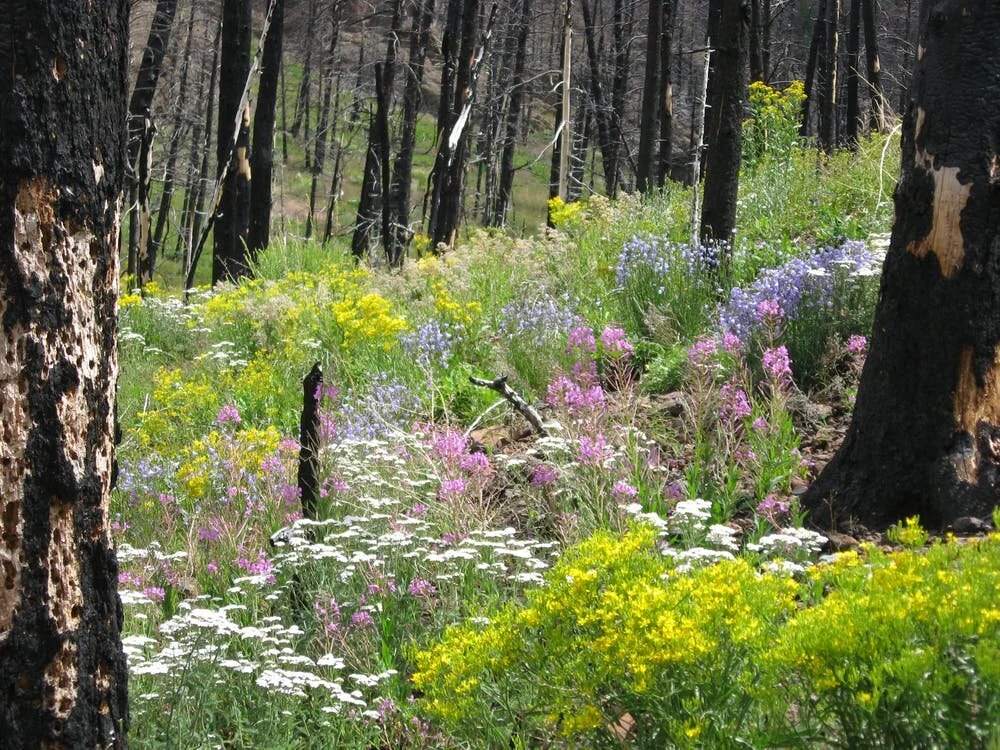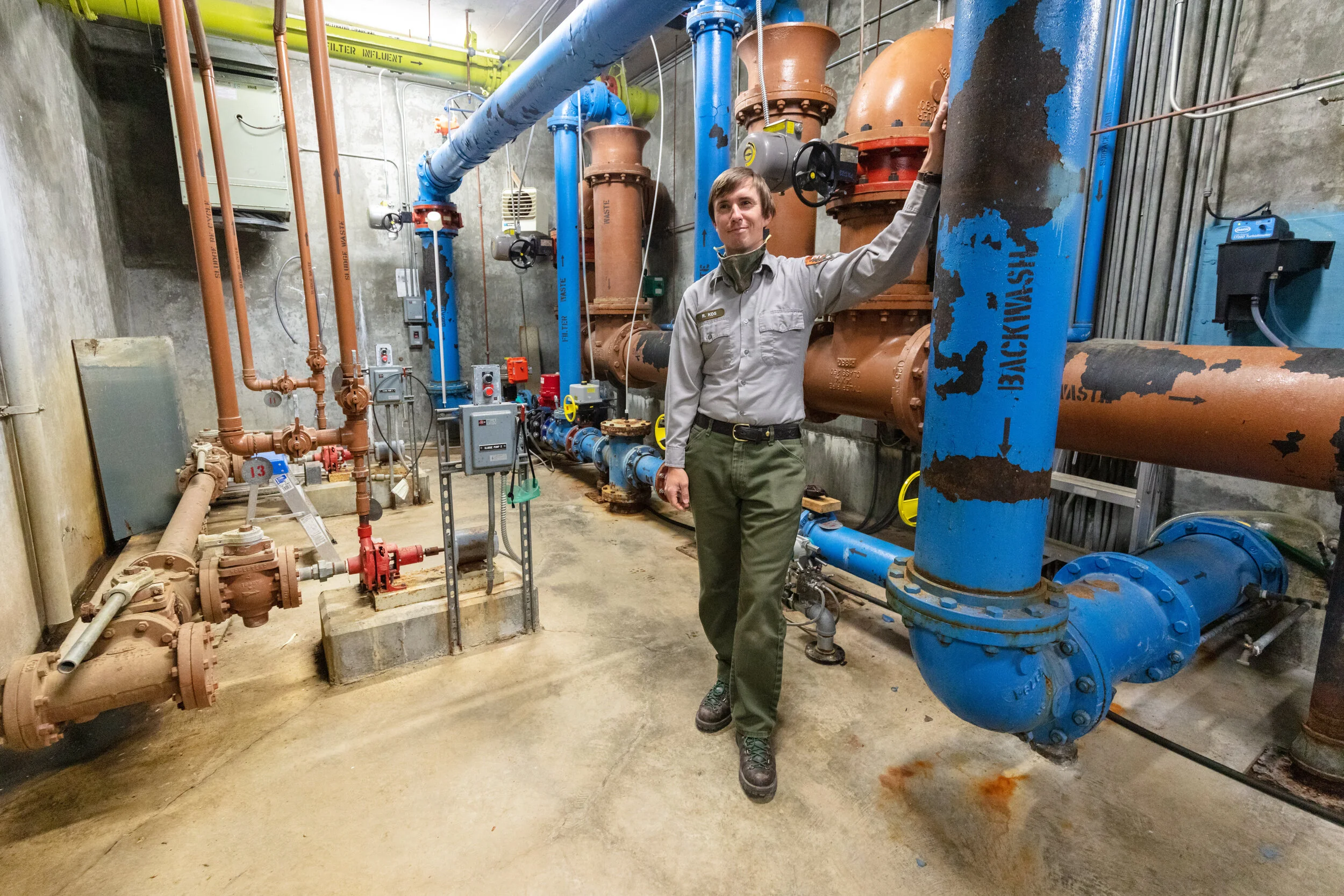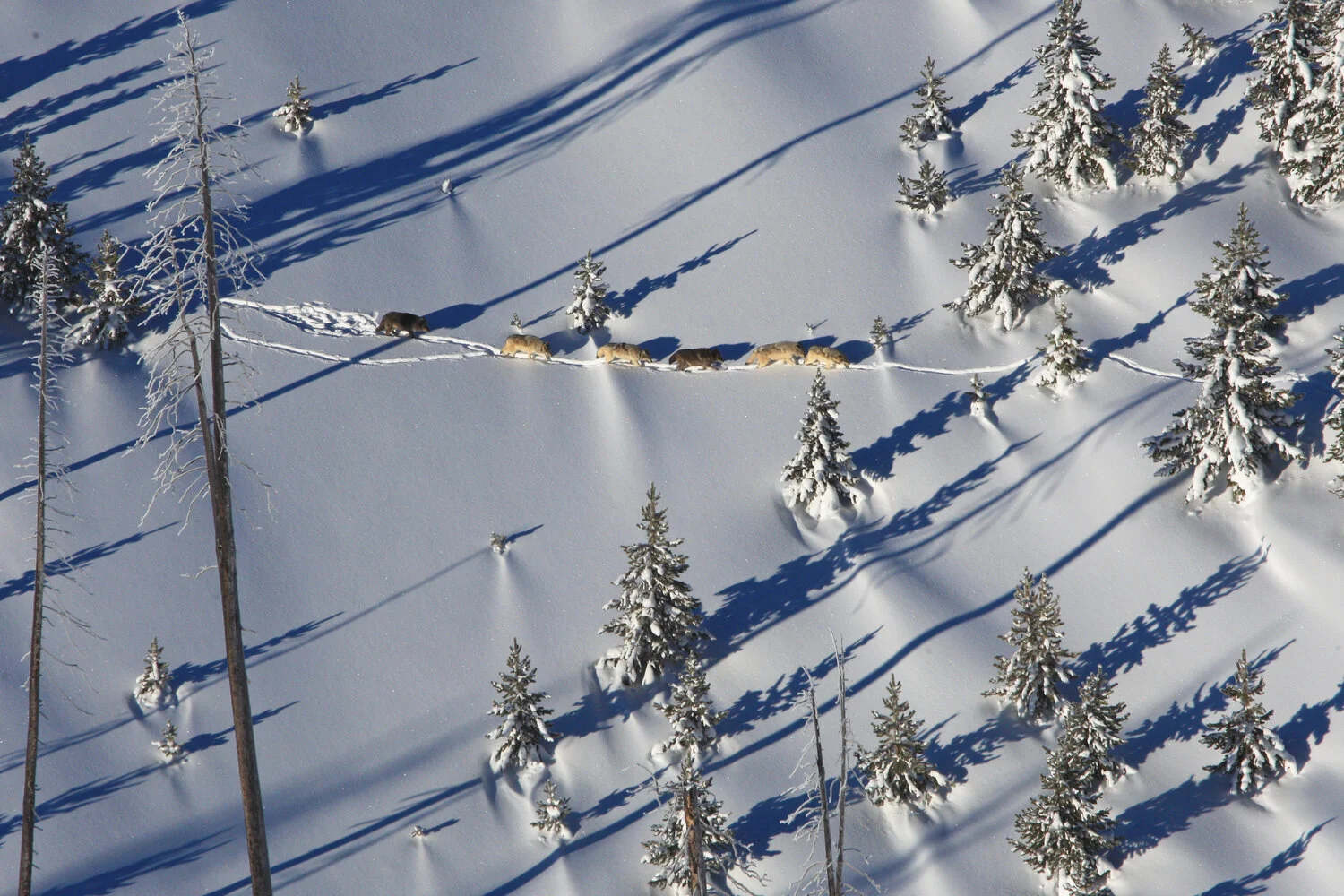
CASE STUDY
Yellowstone National Park
Cultivating organizational resilience using lessons from nature.
There are many reasons to visit Yellowstone National Park. Bison and bears. Soaring vistas. Geysers hosting conditions of first life on earth. Peace and inspiration in the most intact ecosystem in the lower 48 states. As more and more people seek to experience nature, this iconic park faces new and unexpected challenges.

BISON JAM, HAYDEN VALLEY. Free-ranging bison in Yellowstone’s iconic Hayden Valley are a sight to behold. Keeping traffic moving is just one of many challenges facing park employees. Time Lapse: NPS / Jacob Frank.
Challenge
Yellowstone visitation increased by more than 55% over the last two decades – a rate of growth not seen since just after the Second World War. With more visitors came challenges, including traffic, crowding, unsafe visitor behaviors, impacts to natural resources, car accidents, vehicle collisions with wildlife, and employee stress and safety.
As funding and staffing levels remained flat in the midst of these challenges, Yellowstone’s systems, employees, and infrastructure were stretching thin. Never had the National Park Service’s mission been more important or more challenged: protect the park’s natural and cultural resources for the enjoyment, education, and inspiration of current visitors and future generations, and expand the benefits of experiencing Yellowstone to ever-growing domestic and global populations.
When we began working with the National Park Service, the passion personnel had for the mission of the park and helping to address its challenges was palpable across levels of the organization. But staff were also stretched thin, morale was suffering, and cooperation across park divisions was lacking.
POST-ERUPTION, OLD FAITHFUL. Witnessing the world’s most famous geyser is no longer only an American dream. A growing international middle class seeks to experience landscapes of the Western U.S. Photo: NPS / Neal Herbert.
MORNING HAS BROKEN, GRAND PRISMATIC SPRING. Images of Yellowstone’s unique wonders have gone viral on social media leading to visitation hotspots. Time Lapse: NPS / Jacob Frank.
MANY HATS, NORTH ENTRANCE. The distinctive hat and badge of a park ranger bring many duties. Resource protection, as well as visitor safety and education, are the tip of the iceberg. To facilitate gate efficiency, this ranger answers questions and sorts cars that already have a park pass . Photo: NPS / Jacob Frank.
Strategy
From 2015 - 2020, NatureWerks applied tools from ecology, sociology, and business management to assist park leaders in responding to visitation challenges and improving organizational culture and capacity.
Outcomes
Analyzed social and environmental challenges in space and time.
Facilitated interviews, focus groups, and workshops to understand employees’ perspectives.
Teamed with park management to develop new strategies and resources.
Supported the park in restructuring and empowering multi-level leaders.
Developed strategies and partnerships to understand and manage visitation more effectively over time.
WORKSHOPPING, WEST YELLOWSTONE, MONTANA. NatureWerks co-founder, Ryan Atwell, engages a small group of employees from different operating divisions in the park’s West District in order to ground truth and revise preliminary findings. Photo: NatureWerks.
NatureWerks earned the trust of employees at all levels. People felt like they were being listened to, and their ideas mattered. The approach has helped the park restructure and improve its leadership and culture.
Former Chief of Staff, Yellowstone National Park
Approach
Listen
Observations and questions are the critical, but often overlooked, first steps of the scientific process. They are also the foundation of good business practices. NatureWerks began work in Yellowstone by spending two months observing and documenting challenges and opportunities across a large park.
During this time, we engaged the perspectives of hundreds of park staff members in candid conversations, interviews, focus groups, and surveys. Through analysis, we uncovered critical themes that arose through our observations, data, and conversations.
Connect
We further refined these themes in workshops designed so that frontline employees and top leaders could hear one another’s perspectives. Employees were full of constructive ideas to address challenges in their areas of the park, but the park lacked the additional resources and organizational mechanisms to vet them, make decisions, and implement new approaches.
Hearing one another’s perspectives began to help employees understand that advocating for the park’s mission looked very different across its operational levels. This broadening of perspectives built trust, while also exposing critical gaps and opportunities for change in the park’s operational systems.
Reframe
Building off research and best practices in both business management and ecology, NatureWerks worked with the park to refine its organizational structure and leadership style. Rather than seeing supervisors and mid-level managers’ as primarily technical managers within their operating division, the park chose to prioritize their role as relationally-oriented leader/coaches.
These changes demanded that mid-level leaders to be able to work together across boundaries and make decisions that balanced field-level and management-team input. Their jobs would sync the roles of interdisciplinary frontline teams with the park’s historic mission and evolving priorities for addressing emerging challenges.
Change
Based on this reframing, Yellowstone’s leadership drafted park wide priorities for responding to visitation challenges. They also restructured the geographic districts of the park to increase parity among operational divisions. Several positions were reorganized, and new positions were added, to create “district leadership teams” that shared responsibility with senior management for park leadership and decisions.
To respond to challenges that come with change in decision-making processes, NatureWerks worked with the park to facilitate workshops among senior and mid-level leaders. These workshops integrated leadership training, working through focal park issues collectively, and modeling/refining best practices going forward.
MORE WORKSHOPPING, MAMMOTH HOT SPRINGS. Senior and mid-level park leaders formulate best practices for working across operating divisions to implement key decisions at the district level. Photo: NatureWerks.
Lessons from Nature
1. Responding to Change
Natural systems rely on healthy change to create a diversity of niche spaces and new opportunities. For instance, the edge habitats, forest gaps, and resources made available in the aftermath of a forest fire create habitat for different assemblages of plant and animal species. In the same way, effective organizations anticipate change and build diverse and resilient human resources to respond in adaptive and innovative ways.
During the last decade as YNP visitation increased and became more global, park systems, staffing levels, and infrastructure were slow to change, resulting in systems that were overwhelmed and could not effectively respond. For instance, park operating divisions were narrowly specialized to accomplish the specific tasks needed to effectively run a park during the busy summer season. They lacked space and resources to respond to new types of visitation challenges.
We worked with the park to empower staff with more open communication networks and cross-boundary tools to address emerging challenges. We also built and funded public-private and cross-agency partnerships that could equip park staff with new skills, resources and information.
NEW OPPORTUNITIES, SHOSHONE NATIONAL FOREST, WYOMING. Wildflowers and the pollinators that depend upon them flourish three summers after the Gunbarrel Fire burned just east of Yellowstone in 2008. Historically, fires created patchy mosaics of habitat releasing resources and creating new edge habitats and niche spaces. Photo: Monica Turner.
Nature is all about relationships. It takes a breadth of interconnected players to maintain ecosystem balance in the midst of constant change. Humans are no exception. We evolved to work together in groups, depending on one another to survive and thrive. Perhaps unsurprisingly then, employees’ favorite parts of their jobs were not only the natural wonders of the park itself, but also their colleagues and the interdependent small-town fabric of life in the communities around the park they called home.
However, as the increased intensity of their work led to stress and exhaustion, many Yellowstone employees and park partners fell back on narratives of rugged individualism or loyalty to their immediate team to keep plugging away. At the same time, morale was dropping and resentment towards the park as an organization was building.
Through our analyses with park staff, it became apparent that park teams were more satisfied and most effectively responded to challenges when they were able to work fluidly with employees whose jobs were different from their own. We empowered the park to better steward the relationships that are so vital to the health and happiness of its employees and the success of its mission.
2. Integrity of Relationships
ENVIRONMENTAL ENGINEER, LAMAR VALLEY. In a dry ecosystem, beavers create and maintain essential habitat for hundreds of other species. Photo: Neal Herbert.
ENVIRONMENTAL ENGINEER, MAMMOTH HOT SPRINGS. This utility systems operator provides clean water and waste management for Yellowstone’s 4 million visitors. It takes over a dozen villages comprising 800 National Park Service employees and thousands of park partners working behind the scenes to get the park through a busy summer season. Photo: Jacob Frank.
Many moving pieces undergird the resilience of Yellowstone’s ecological and social systems; they also complicate the job of science and management. The rule of hand, a theory for managing complex social and ecological systems, states most systems have no more than 5 key variables that are disproportionately responsible for driving system outcomes of interest. What is more, some of these variables are likely external in nature and outside of the control of local actors.
Organizations can most incisively respond to change by focusing on the interactions between these focal variables, with special attention to internal drivers that can be leveraged effectively. In the midst of many factors beyond Yellowstone leaders’ control, we helped identify two internal factors over which the park had a high degree of leverage — working across organizational divides and empowering mid-level leaders. Taken together, changes in these areas had potential to allow the park to respond more effectively to externally driven changes over which it had less immediate control.
3. The Rule of Hand
TROPHIC CASCADES, GREATER YELLOWSTONE ECOSYSTEM. In nature, creative tension between bottom-up and top-down pressures keeps an ecosystem in dynamic balance. Often a few key variables play a disproportionate role in driving focal outcomes. In Yellowstone, top predators, ecological engineers such as beavers, and human impacts like climate change and invasive species are focal priorities of research and management. Image: NatureWerks.
4. A Creative Tension: Bottom-Up – “Revolt!” Top-down – “Remember”
In both social and ecological systems, bottom-up actors are quick to respond to change, address problems, innovate, and find new niches. Top-down forces offer stability and seek to dampen radical change that could throw the system out of balance. In healthy systems these two forces work in creative tension.
In Yellowstone’s organizational hierarchy, these top-down, bottom-up tensions were creating internal conflict and gridlock. In addition, siloed organizational structure was making it difficult for employees to work across boundaries to solve problems. We worked with the park to make the values and perspectives of employees working in different levels and divisions of the park explicit to one another.
As a result, Yellowstone made a number of changes. The structure of the organization was modified to make collaboration more effective. Pilot projects were developed to test and refine how communication and decision-making worked across organizational levels. Social networks were analyzed and trainings developed to encourage cross-pollination.
CROSSING BOUNDARIES, GARDINER, MONTANA. A pair of mid-level leaders from different divisions compare notes and review logistics during a special event outside Yellowstone’s north entrance. Photo: Neal Herbert.
5. The Essential Role of Mid-Level Leaders
Science from business management shows how organizations most effectively respond to change by empowering mid-level leaders with strong relational skills to inspire and lead teamwork across boundaries. This echoes findings from ecology showing how keystone species across different levels of an ecosystem facilitate health and survival of many other organisms and interrelationships.
In Yellowstone, as in many organizations, mid-level managers were seen primarily as competent technical experts, rather than coaches and leaders whose job it was to bring people together to work for mission-oriented change. To address this, the park created teams of mid-level leaders to whose job it was to coach employees, while partnering with one another and park management to communicate priorities and make cross-cutting decisions.
We facilitated workshops in which the management team and these leaders worked together to develop and practice a strategy for communicating and making decisions across organizational levels and divisions. This included a sense of shared leaders’ intent for how all employees in the park contributed to the park’s mission and current priorities. It also involved clear guidance that empowered leaders to work together to make decisions at the local level, and guidelines for decisions that needed to be vetted with the management team.
Leading from Behind, Pelican Valley. Leaders like the aging alpha female of the Mollies pack (black wolf on left) are not always the strongest or fastest wolf in the group. But they provide vision, navigate conflict, and keep everyone moving in the same direction. Photo: NPS / Kira Cassidy.











